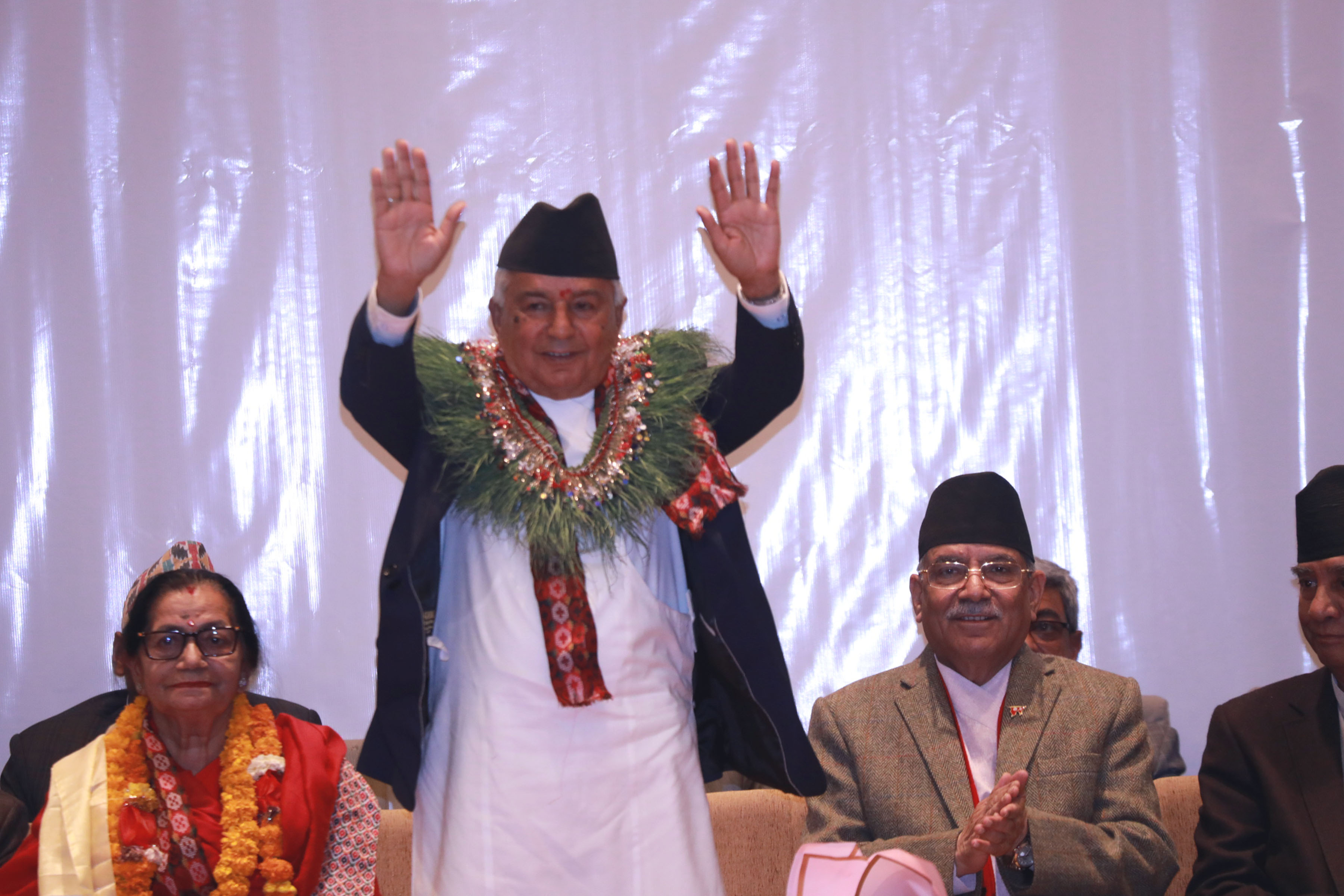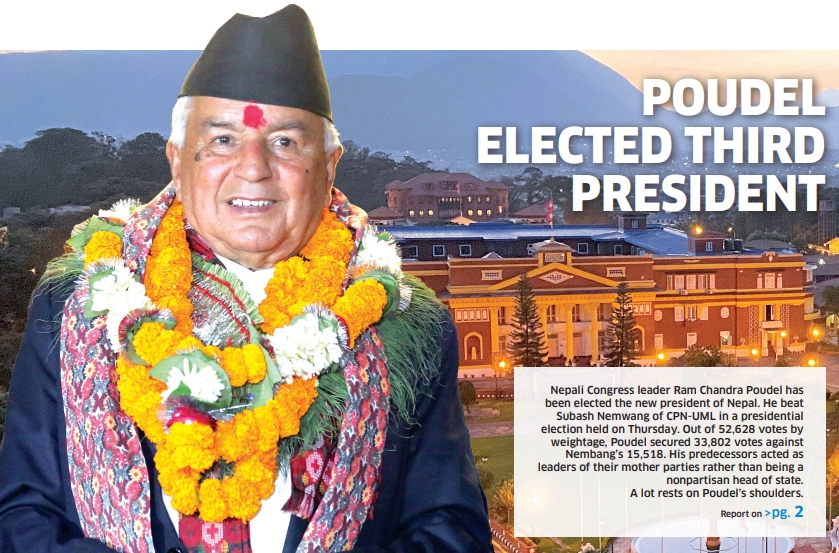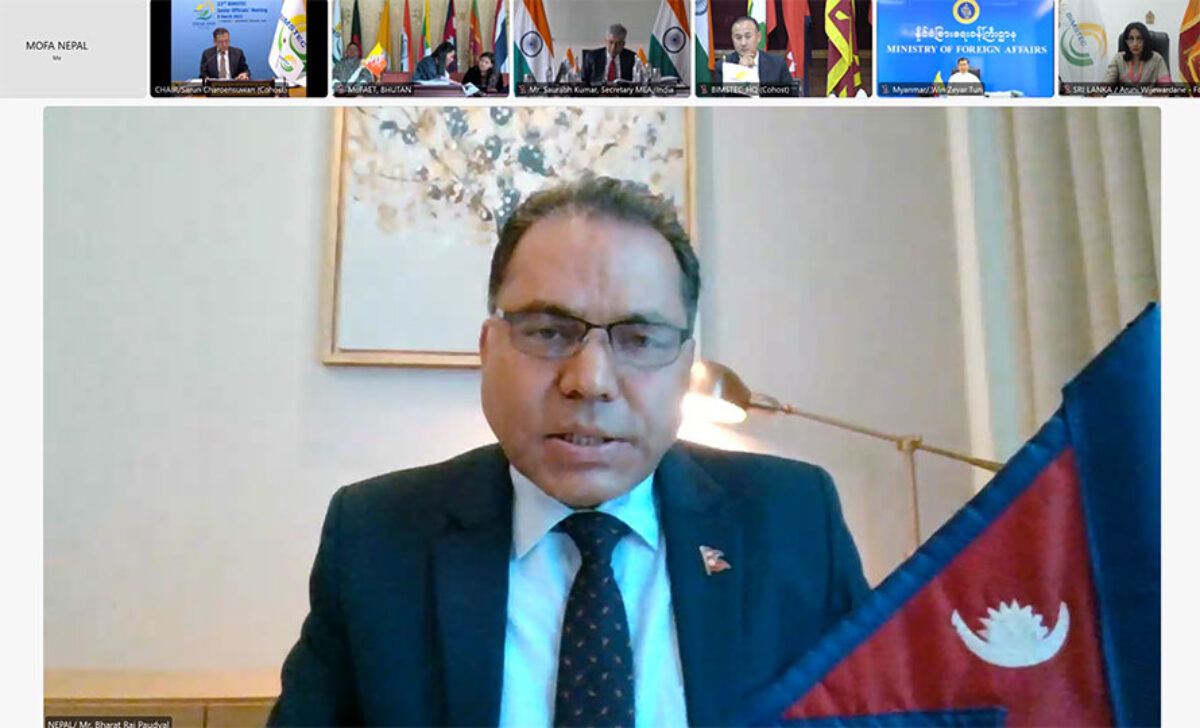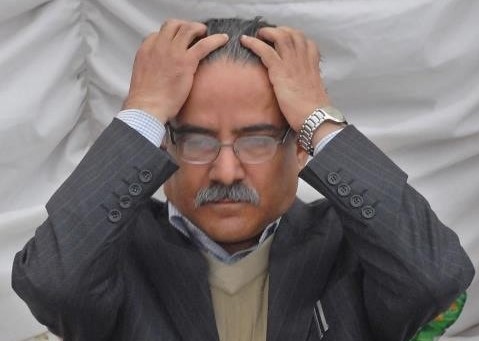Suman Adhikari: No hope from new amendment bill
Amid protests from victims of the decade-long insurgency, Minister for Communications and Information Technology Rekha Sharma, on behalf of Prime Minister and Law Minister Pushpa Kamal Dahal, tabled a Bill to amend the Enforced Disappearances Enquiry, Truth and Reconciliation Commission Act in the House of Representatives. Pratik Ghimire of ApEx talked to Suman Adhikari, a conflict victim, to get his views on the Bill.
What’s your take on the transitional justice amendment Bill?
This Bill is just a dust in the eyes of the public. If successive governments had cared about us, they could have addressed our demands very early. The incumbent government has shown some interest to amend the Bill under much pressure. Concerned authorities drafted this instrument to serve their interests, so it is full of loopholes. For one, it has not incorporated the sentiments and demands of the conflict victims’ community.
What were your demands?
The Bill states that the tenure of the Truth and Reconciliation Commission shall be of two years. But it is mum on the organizational structure of the commission, its human resource and infrastructural requirements and how it will work with different tiers of the government. The Bill is mum on the jurisdiction of the commission. Also, the tenure of the commission is not the only issue. Who all are appointed at the commission and how effectively it works; these are crucial issues. If appointments are made on the basis of recommendation from political parties, victims like us will have to suffer.
Most importantly, we wanted this draft prepared after consulting us (the victims) and incorporating our recommendations as nobody knows the pain better than us. But the drafters of the Bill never sought our suggestions. It always appears that they are doing it all for themselves, not for us. The time has also come to review the transitional justice system.
What’s your comment on political parties’ stances?
No major party seems committed to this matter. The Nepali Congress never speaks on this topic. I was amazed to find that not a single lawmaker from the CPN-UML spoke while the Bill was being presented in the parliament. Rastriya Prajatantra Party’s Gyanendra Shahi commented on the Bill but we don’t know whether it was his personal opinion or his patry’s. Even the Rastriya Swatantra Party was silent. We had not expected this. Only Nepal Majdoor Kisan Party and Rastriya Janamorcha took a stance in our favor.
What about the international community?
They too are silent. The embassies in Nepal used to talk on this matter quite frequently a few years back. But these days, it’s rare to find them talking .
What next for the conflict victim community?
Even in the victim community, there is no single voice. Many victims are still supporting the steps of the political parties, while many others don’t care. Others like me are raising our voices constantly, we will continue to do so peacefully. We need the rule of law in the nation and justice. That’s all.
Many ministerial aspirants inside Congress
The Nepali Congress has officially decided to join the coalition government led by CPN (Maoist Center). The two parties, which had forged an alliance to contest the general election in November last year, had fallen out over a power-sharing dispute after the polls and gone separate ways.
The Maoist went on to form a government with the primary backing of the CPN-UML on 25 Dec 2022, while the NC helmed the opposition. But the Maoist-UML coalition broke up within two months, once again bringing the Maoist and NC together. With this, a race has begun inside the NC for ministerial posts.
A party meeting on Sunday set criteria for ministerial candidates to represent the party in the Pushpa Kamal Dahal-led government. Congress Spokesperson Prakash Sharan Mahat said candidates would be selected on the basis of academic qualifications, contribution to the party, inclusivity, and balance of power at the provincial level.
President Sher Bahadur Deuba will pick the candidates on the basis of policy-decision taken by the party, he added. Prime Minister Dahal is set to give full shape to his Cabinet after taking the vote of confidence in Parliament on Monday. The NC has demanded eight ministries in the Dahal government in order to accommodate the leaders from the camps led by Shekhar Koirala, Krishna Prasad Situala, and Prakash Man Singh. He must also make room for some leaders from President Ram Chandra Poudel-led faction as well as his own supporters.
One Congress leader told ApEx that Deuba has a tough job of satisfying everyone inside the party, including those from the rival factions. Members of the chief rival camp, led by Koirala, had backed Deuba’s decision to give the trust vote to Dahal back in January, and now they expect the party leadership to reciprocate the gesture by offering them positions in the government. It is almost certain that the NC will get two vital ministries—finance and foreign affairs.
It is said Deuba’s spouse Arzu Deuba has shown interest to lead the foreign ministry, while Mahat is trying to land the finance portfolio. Senior leader Singh, who fought for the party presidency and later supported Deuba, is said to be making a bid for deputy prime ministership to lead the NC in the government.
Bishnu Dahal: America wants a favorable government in Kathmandu
Nepal has seen a continued political shift since the general elections of November last year. Amid this fluidity, the interest of external powers in Nepal seem to have gone up. There have been several high-level visits to Nepal from the US, India and China over the past recent months. In this context Pratik Ghimire of ApEx talked to political analyst and Tribhuvan University lecturer Bishnu Dahal about Nepal’s political and geopolitical situations.
Why do you think the old coalition reunited?
In internal politics, the factor remains the same, but the variable factor is geopolitics. When the CPN (Maoist Center) broke the coalition with the Nepali Congress to form an alliance with the CPN-UML, the China-card played an active role while the Indian and US-side failed to carry out their task. But as the old coalition has been reunited, I see the initial point of this event is the Millennium Challenge Corporation (MCC) compact’s endorsement from parliament. As soon as the case of MCC arose, the then Nepal Communist Party (NCP) split, and the US got the Nepal government close to them.
Also, as the Sher Bahadur Deuba-led government voted in favor of Ukraine in the UN, it can be clearly believed that we were in the US-led team. The Americans want a favorable government in Nepal for which they are showing their direct involvement. As soon as Pushpa Kamal Dahal became the prime minister, China-funded Pokhara International Airport was inaugurated, a Chinese team came for Kathmandu-Kerung railway study, and the Chinese side opened all the borders. But the US successfully took the game into its own hands. That is why the Maoists and Nepali Congress are now together.
Why do you think external forces are so interested in Nepal?
External forces come to Nepal because they see a lack of national interest and policy here. Our politicians have no political or national interest. All they have is personal interest because they always want to be in power. Nepali politicians actually invite external forces and play with them to retain power. And, the external forces like this situation because they get to project their power here. India and China always want to be in Nepal to counter each other. As for the US, it feels that it could influence Nepal and bolster its presence in the South Asian region from here.
Do you think India's influence in Nepal has tempered down in recent years?
We are largely dependent on India. But the data has been changing. In recent years, rice import from India has declined by (around) 30 percent. Not due to our production, but a lot of people are leaving Nepal for employment and study. But these people are not going to India. They would rather go to Western countries and the Persian Gulf nations. So, not only the political presence of India, but also the economic presence has been shifting to Western nations, especially to the US. And I have already mentioned how we are tilting toward America and why they want to be with us.
How do you see the South Asian geopolitical scenario?
Though India and the US are close to each other these days, India has maintained a good relationship even with the enemies of the US. For example, India has maintained cordial ties with Russia and Iran for its own benefit. Even India and China have a good economic relationship. India has come closer to the US because China has enclosed India from all sides. Sri Lanka’s Hambantota International Port and Pakistan’s Gwadar Port are controlled by China.
In the South Asian region, India has the business of around $7trn, whereas China’s is of around $18trn. Though India is doing good, China has an upper hand. I see India has both opportunities and threats from China and the geopolitical scenario of South Asia is often determined by the activities of these two nations. I hope India will review its neighborhood policy to address the problems.
Where do you see the future of Nepal in this geopolitical climate?
The geopolitical game is always there. It’s not just in Nepal and in the South Asian region, but across the globe. This comes with both opportunities and threats. For instance, the US eagerly wants to invest in our hydropower projects. We will have the opportunity to create employment by establishing large-scale industries. But if our politicians fail to grab the political opportunity for national interest, it will not help us, and we will become just a puppet and playground of big nations.
World Cup calling?
Nepal reached the ICC Men’s Cricket World Cup Qualifiers after defeating the UAE by nine runs. The game was decided by Duckworth-Lewis (DL) method as the second innings had to be reduced to 44 overs due to bad light. Nepal scored 269 runs by losing six wickets in their final match of the triangular series of the World Cup League 2 played at the TU cricket ground on Thursday.
For Nepal, Kushal Bhurtel played a half-century of 50 runs in 35 balls with three fours and four sixes. Similarly, Bhim Sarki got out after playing a magnificent knock of 67 runs in 76 balls with nine fours while Aarif Sheikh made 52 runs off 62 balls with two fours.
Gulshan Jha remained unbeaten on 50 runs while Dipendra Singh Airee scored not out 10 runs. Junaid Siddiqui took the most wickets (three) for UAE, while Ayan Khan and Zahoor Khan got two and one, respectively. UAE decided to bat first after winning the toss and made a total of 310 runs by losing six wickets.
Asif Khan, who came to the crease at number six for UAE, scored an aggressive century with four fours and 11 sixes in 41 balls and remained not out. Vriitya Aravind, who shared 135 runs partnership with Khan for the sixth wicket, played an innings of 94 runs off 138 balls with eight fours and two sixes.
UAE skipper Muhammad Wasim returned to the pavilion after making 63 runs off 49 balls with two fours and six sixes. For Nepal, Airee bowled economically by giving 19 runs in eight overs. He took two wickets with two maidens. On their part, Lalit Rajvanshi, Sompal Kami and Sandeep Lamichhane took one wicket each. With this win, Nepal climbed to the third position of the league and has secured a place in the global qualifiers for the World Cup that will kick off in Zimbabwe on June 18.
Scotland have already become League 2 champions while Oman have finished second. Both teams will join Nepal in the global qualifier. It will feature ten teams in total, the bottom five teams from the World Cup Super League, the top three teams from the World Cup League 2, and the top two teams from the 2023 World Cup Qualifier Play-off.
It is certain that Nepal will play against Zimbabwe, the Netherlands, Oman and Scotland in the qualifier, while the remaining five teams are yet to be decided. Top two teams from Zimbabwe qualifiers will play the ICC World Cup that is set to take place in India, in October 2023.
Know your new president
Born to Durga Prasad and Hrishimaya Poudel on 14 Oct 1944 in Tanahun, Ram Chandra Paudel completed his schooling from Nandiratri Secondary School, Naxal, Kathmandu in 1963. He has a master’s degree in arts from Tribhuvan University. He is married to Sabita Poudel and they have four daughters and a son.
Paudel was inspired to join the democratic movement at the age of 16 after the dissolution of the popularly elected parliament and imprisonment of leaders including then prime minister BP Koirala in Dec 1960. He was associated with the Armed Insurrection Movement for the restoration of democracy, and initiated the students’ movement in 1962. Paudel was given a role in organizing Nepal Student Union in 1970 and got elected as a senior member of the committee of the union. His national political career began in 1977 after he was elected a member of the Nepali Congress Tanahun District Committee. Soon he rose the ranks and became the vice-president and president of the district committee.
In 1983, he was made the coordinator of the Nepali Congress’s Central Publicity Committee. Paudel went on to become a member of the Central Committee member of the party and was made the chief of its central level Publicity Bureau in 1987. In the general election of 1991, he was elected a Member of Parliament from Tanahun-1. He served as the minister for local development and agriculture for around three years. Poudel was reelected from Tanahun-2 In 1994.
This time he was elected the speaker of the House of Representatives (lower house) and served until 1998. He also served as Minister for Home and Deputy Prime Minister from 1999 to 2002. In 2006, after the Maoists joined peaceful politics, Paudel was appointed the coordinator of the Peace Secretariat that included representatives from top political parties. He was appointed Minister for Peace and Reconstruction in 2007.
In between, he was made the General Secretary of the Nepali Congress’ Central Committee and was later promoted to Vice-president of the same committee in 2007. In 2008, he was elected as a member of the first Constituent Assembly from Tanahun-2 and was elected as Parliamentary Party Leader of Nepali Congress.
After Pushpa Kamal Dahal resigned from the post of prime minister in 2009, Poudel contested for the post of premier for 13 times, but failed to pass the threshold. Poudel was elected the vice-president of Nepali Congress from the 12th general convention of the party. He served as the acting president of the party after the demise of then party president Sushil Koirala.
Paudel was elected as a Member of Constituent Assembly from Tanahun-2 in 2013 and Member of Parliament in 2022. He was defeated in the parliamentary election in 2017 by CPN-UML candidate Krishna Kumar Shrestha.
In his political career, Paudel was detained and jailed several times. The longest time he spent in jail was from 1971 to 1975 for being involved in various activities of the student movement, soon after the release of deposed Prime Minister BP Koirala from Sundarijal Jail. He was charged for taking part in a protest program against the Ramailo Jhoda scandal (Morang). In this period, BP Koirala met him at Central Jail and told him not to be distracted, which inspired Paudel to lead the democratic movement, he often says. It was there that Paudel met Koirala for the first time.
He has also published a few books: ‘A Brief history of Nepali Congress’, ‘Democratic Socialism A Study’, ‘What does the Nepali Congress say?’ and ‘Agrarian Revolution and Socialism’ among others. Within the party, Paudel is known as a coordinator and moderate leader. He also played a moderate role in the historic negotiations and consensus to bring the Maoists into mainstream politics and is also known as the drafters of the 12 points Consensus and Comprehensive Peace Agreement.
What should be the role of the new president?
Veteran Nepali Congress leader Ram Chandra Poudel has been elected as the new president of Nepal. He is the third elected head of state after Nepal abolished monarchy and became a republic in 2008. Poudel succeeds Bidya Devi Bhadari who served two terms after Dr Ram Baran Yadav, the first president. Although the post of the president is ceremonial in nature, the past two presidents have courted controversies for acting in favor of their political parties, instead of being a nonpartisan head of state and protector of the constitution. In this context, Pratik Ghimire of ApEx talked to some experts and politicians to solicit their views on what role the new president should play.
Binoj Basnyat, Security analyst

With the indications of current political turmoil and desperations of parties over the presidential post, it has been proved how important this post is despite being a ceremonial one. The President should safeguard national interest and unity. The predecessors, being active members of political parties, took controversial steps. This time, too, we have a senior political leader as President. To avoid controversies, he should stay away from party politics. As the supreme commander-in-chief of Nepal Army, the President has a role to play during national crises. He should also play a role to strengthen our diplomacy, and advise the government to revive our failing economy.
Bipin Adhikari, Constitutional expert

Our constitution has mandated dozens of works and responsibilities to the President. The new President should fulfill his constitutional roles while following the protocols. As the roles of Prime Minister and President are interrelated, they should complement each other. The President has no power to go against the government but in case of a minority government, he can use his conscience to guide the country. Even when the government issues ordinances, the President should have the gumption to suggest the PM to wait for the parliamentary session and follow due process. If the president truly abides by the Constitution, he can do no wrong. In case of a difference of opinions on matters of national interest between the President and the PM, it should be made public to facilitate a healthy debate.
Gopal Khanal, Politician, CPN-UML

As the President is the custodian of the Constitution and the guardian of the nation, he should always work for the greater good of the people. Sometimes the executive tries to misuse power, the President should prevent such a situation. The head of state should maintain the check and balance of powers. In Nepal, President has no executive powers, but that doesn't mean the former should act like a rubber stamp in service of the PM. I have mixed feelings regarding past Presidents and their tenures. They came through political struggles and deserved the post more than anyone else, yet, political parties dragged them to controversies. The new President should always analyze what the political parties expect from him, while upholding national interest, unity and integrity.
Shankar Tiwari, Analyst

The new President should avoid controversies and also correct the presidential course. He should work within the constitutional framework. The PM and the President should meet at least once a week to discuss national and geopolitical affairs; there should not be any communication gap between them. Lastly, the motorcade of the president must not hamper the public. The new president should think of other alternatives.
Bishnu Dahal, Political analyst

As both presidential candidates had served as the speaker of the House, they know how to be above their political parties and how to act in accordance with the Constitution. As for Ram Chandra Paudel, he has a democratic background, and as a senior leader of Nepali Congress, he knows how to follow democratic rules. So, I think, he will disassociate himself from the party and follow the Constitution. He must help the government to make Nepal a sound nation geopolitically. The outgoing president has left behind a series of controversial decisions for the new one to learn from.
Bishnu Bhattarai, Senior advocate

The President should promote national unity. The political parties could not arrive at a consensus on the head of the state. This means the President will be a partisan figure and such a figure cannot be the symbol of national unity. No elected political figure shall ever hold the presidency because s/he will always be a divisive figure.
Ananta Raj Luitel, Constitutional law expert

According to the Constitution of Nepal, the President is a nominal head of the state. He/She cannot take any discretionary decision but needs to act on the basis of the recommendation of the Council of Ministers, the Constitutional Council and the Judicial Council or other relevant recommending authority. The President should stay within these bounds.
BIMSTEC passes key instruments as SAARC stalls
The 19th ministerial meeting of the Bay of Bengal Initiative for Multi-sectoral Technical and Economic Cooperation (BIMSTEC) on Thursday passed some key instruments, giving a fresh impetus to the regional body.
The ministerial meeting endorsed important instruments including the BIMSTEC Bangkok Vision 2030, agreement on maritime transport cooperation, rules of procedures for several mechanisms, terms of reference for Eminent Persons’ Group, inclusion of blue economy, mountain economy and poverty alleviation under the purview of reconstituted sectors. The meeting was held virtually in Bangkok, and Nepali delegation was led by Foreign Secretary Bharat Raj Paudyal.
Addressing the meeting, Paudyal called for meaningful regional cooperation to deal with the defining challenges of our times such as climate change, energy crisis, food insecurity and the large-scale pandemic. Recalling the fourth BIMSTEC Summit held in Kathmandu in 2018, which aptly prioritized institution building of BIMSTEC, Paudyal underlined the need for conscious, credible, and concerted actions to achieve a more resilient, prosperous, and sustainable Bay of Bengal region.
Paudyal also updated on the progress achieved in the Sector of ‘People-to-People Contact’ that is being led by Nepal. He also informed the meeting on the efforts made toward creating platforms for people-to-people engagements in the BIMSTEC region, such as the Parliamentarians and Speakers forum, and separate forums of entrepreneurs, universities, and researchers, etc.
Over the past few years, BIMSTEC has gathered momentum, while another regional body, South Asian Association for Regional Cooperation (SAARC), remains stalled since 2016 over the India-Pakistan dispute.
Though Nepal is taking initiative to revitalize the SAARC process, other member countries, particularly India, are not serious about it. Preparations are underway to hold the sixth BIMSTEC summit but the future of SAARC is uncertain.
Loose lips sink ships
Prime Minister and Maoist party leader Pushpa Kamal Dahal is in trouble for his self-incriminating speech three years ago, where he claimed responsibility for 5,000 lives lost during a decade-long insurgency. Advocates Kalyan Budhathoki and Gyanendra Aaran on Tuesday filed separate petitions at the Supreme Court demanding legal action against Dahal.
“We are registering this case to bring to justice the people responsible for the atrocities and injustices committed against civilians during the conflict period,” said Budhathoki.
Aaran added they were compelled to knock on the door of the Supreme Court after their repeated calls to address the flaws seen in the transitional justice process went unheard. “We have filed the case on behalf of a handful of conflict-affected families, but in reality we are representing the families of 5,500 people killed at the hands of Maoist insurgents.”
Hearing on the case has been scheduled for Thursday. “Prachanda is not free to kill, nor order others to kill,” read one of the petitions. “His public proclamation of taking 5,000 lives is unlawful, so he must be arrested and prosecuted as per existing law.”
Maoists on the defense
The case against Prime Minister Dahal has rattled CPN (Maoist Center) and its breakaway parties. They issued a joint statement on Tuesday, saying they stand against any activity in contravention of the Comprehensive Peace Accord.
“Matters related to transitional justice must be taken through the Truth and Reconciliation Commission. Any act that goes against the transitional justice process will not help in the implementation of the peace accord,” reads the statement. The statement was signed by the Maoist Center, Nepal Samajbadi Party, NCP (Revolutionary Maoist), Nepal Communist Party, CPN (Majority), Scientific Socialist Communist Party, CPN (Maoist Socialist), and Maoist Communist Party Nepal.
National rights body concerned
The National Human Rights Commission also issued a statement on Tuesday, calling on the government, political parties and other stakeholders to conclude the transitional justice process at the earliest. It asked all concerned parties to amend the transitional justice laws in accordance with international standards, and as instructed by the Supreme Court. The national rights body also raised concerns over the objections raised by some political parties concerning the case filed by the conflict victims in the apex court.
“Though transitional justice has a different set of rules and procedures, it is still unjust to bar conflict victims from gaining access to the court of law for justice,” said the statement. The commission said it is worrisome that Nepal’s transitional justice has not concluded even more than 16 years after the signing of the Comprehensive Peace Accord.














